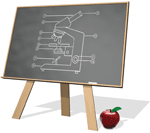Introduction
Foldscope Instruments, Inc. is a San Francisco Bay Area start-up with the explicit mission to magnify curiosity worldwide. Our first and flagship product is the Foldscope, a paper-based microscope that can be manufactured for about $1 in parts. Foldscope was invented by Manu Prakash and Jim Cybulski when Jim was a PhD student in Manu's laboratory at Stanford University. To date, 1.6 million Foldscopes have been distributed to over 150 countries around the world.
The Foldscope is an ultra-low-cost origami-based microscope capable of imaging in brightfield, darkfield, and fluorescence modes. Merging principles of optical design with origami enables high-volume fabrication of microscopes from 2D media. Flexure mechanisms, created via folding, enable a flat, compact design. Structural loops in folded paper provide kinematic constraints as a means for passive self-alignment. This light, rugged instrument can survive harsh field conditions while providing a diversity of imaging capabilities, thus serving wide-ranging applications for cost-effective, portable microscopes in science and education.
Although it costs less than a dollar to construct a Foldscope, it can provide 140× magnification with a 2-micron resolution, weighs less than two nickels (8.8 g), is small enough to fit in a pocket (70×20×2 mm3), requires no external power, and can survive being dropped from a 3-story building or being stepped on by a person. Its minimalistic, scalable design is inherently application-specific instead of general-purpose, providing less functionality at dramatically reduced cost.
In situ examination of specimens in the field provides important opportunities for ecological studies, biological research, and medical screening. Further, ultra-low-cost microscopes provide means for hands-on science education in schools and universities. This platform empowers a worldwide community of amateur microscopists to capture and share images of a broad range of specimens.
Outreach
The most important part of Foldscope Instruments is not the origami microscope, but the communities that use them. As we surpass one million users, Foldscope's community spans many countries, ages, and levels of scientific background. The Microcosmos (https://foldscope.com/pages/microcosmos) is Foldscope's official online community platform. It is a free social network for Foldscope users. Within the Microcosmos, Foldscope users connect, share their data and observations, ideas, and problems. It is a place to collaborate, find inspiration, and learn from fellow explorers.
Foldscope has strong partnerships with school districts, government entities, and organizations around the world. The COVID pandemic forced teachers to quickly come up with hands-on activities that aid learning from home, and it was during this time that Foldscope's partnership with Ector County Independent School District (ECISD, Odessa, Texas) strengthened. In the past few years, we have led in-person workshops, as part of the “2021 Summer Camp Scholars In Progress,” and online workshops as part of the “Professional Development” for educators (Figure 1).

Figure 1: Top to bottom: Camp SiP students worked on a Foldscope project for a week. Online Foldscope training for ECISD educators. One ECISD educator learns how to assemble her Foldscope.
Foldscope aims to cultivate an active community around the world and has recently launched a project called Foldscopes for India, where students from tribal villages receive a Foldscope and are led through scientific explorations by Foldscope trainers based in India. (Figure 2). Another partnership that has allowed Foldscope to reach remote communities is with the non-profit organization Amazon Center for Environmental Education and Research (ACEER). Working with ACEER, Foldscope Team member Paola Moreno-Roman visited the Maijuna community in the Peruvian Amazon and trained the community—with an emphasis on the beekeepers—on how to use the Foldscope to observe pollen and different body parts of bees (Figure 2).

Figure 2: Top: Kids in India excitedly share their scientific observations made through a Foldscope. Bottom (left to right): Foldscope team member Paola Moreno-Roman guides a Maijuna community member on how to use the Foldscope. A Maijuna girl observes pollen through a Foldscope.
Research
Foldscopes have been used in 23 published research studies and papers (https://foldscope.com/pages/publications) across a wide variety of areas such as agriculture, education, public health, animal health, ecology, and machine learning. Patil et al. [Reference Patil1] used a Foldscope in Mharashtra, India as a tool to examine soil samples to identify microorganisms that produce naringinase, an important agricultural and medicinal enzyme, and to explore the use of iodine vapors as an effective screening mechanism for the presence of naringinase (Figure 3). In an animal health-related study, Parada-Sánchez et al. used the Foldscope to support taxonomic identification of Rhipicephalus sanguineus ticks in the field (Figure 4). They found that Foldscope is indeed useful for epidemiological studies in the field and for social outreach programs aimed at raising awareness about vector-borne diseases [Reference Parada-Sánchez2].

Figure 3: Microorganisms from soil samples from a citrus agricultural field around Jalgaon, Maharashtra, India were observed using a Foldscope. These microorganisms were screened for extracellular naringinase production by a simple agar plate assay.

Figure 4: Images of R. sanguineus taken by a phone camera on top of a Foldscope, pointing out different parts of the animal. A. Chelicerae, B. Pedipalps, C. Gnatosome base, D. First coxa, E. Genital opening, F. Anal scales, G. Anal sulcus, H. Festoons. 140× magnification.
Future Endeavors
Foldscope recently launched Training Services, which are educational sessions led by a Foldscope Team Member. These sessions provide highly skilled, guided instruction about Foldscope and various applications. Currently, Foldscope Instruments has an updated version of the Foldscope and other products under development. To find out more about Foldscope Instruments or to purchase a Foldscope visit http://www.foldscope.com. Follow Foldscope on social media on Instagram (@teamfoldscope), and like our page on Facebook (https://www.facebook.com/foldscope).









